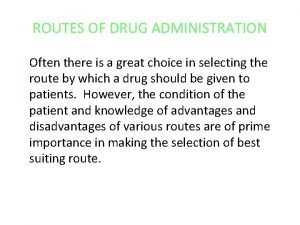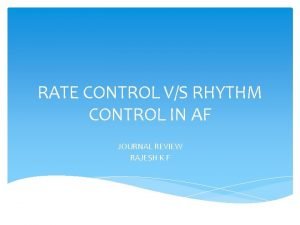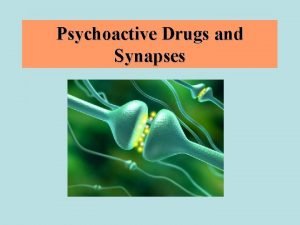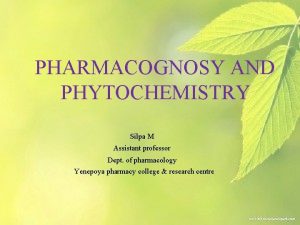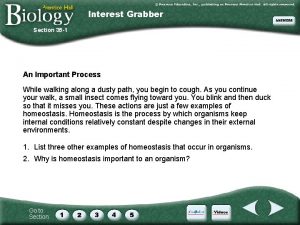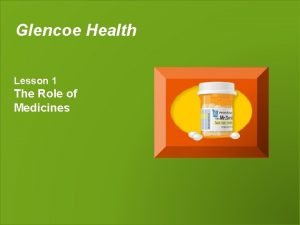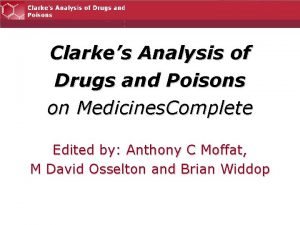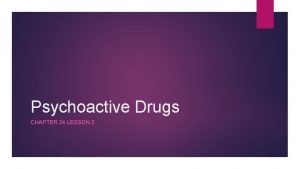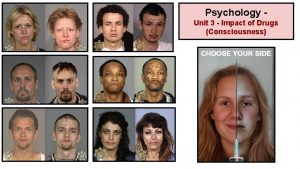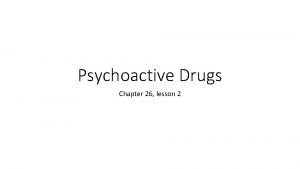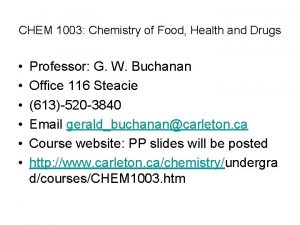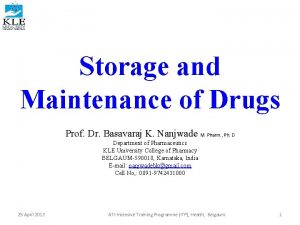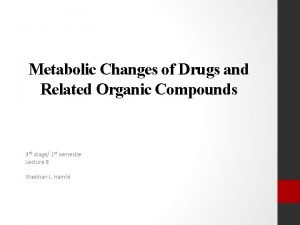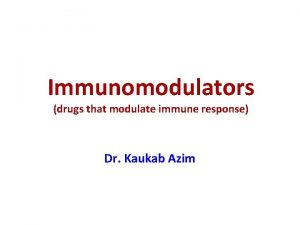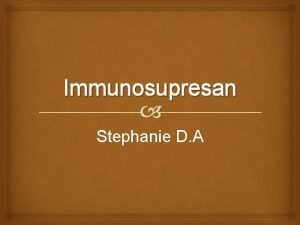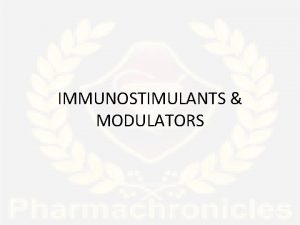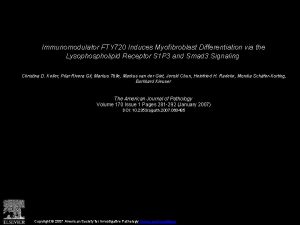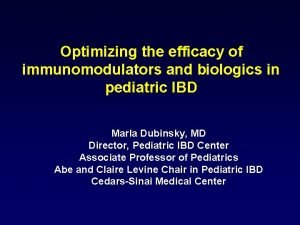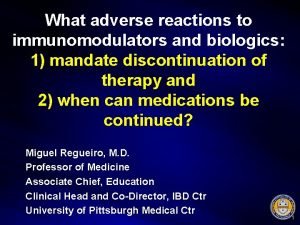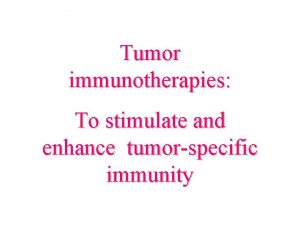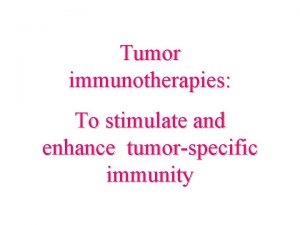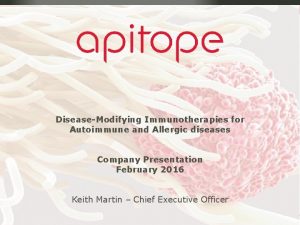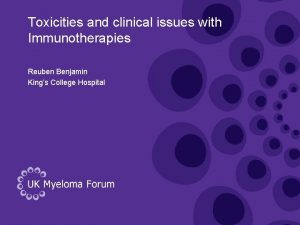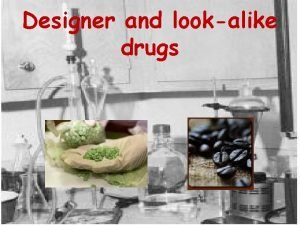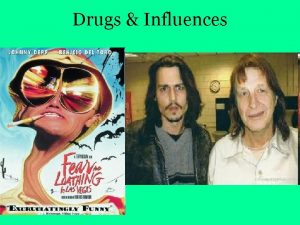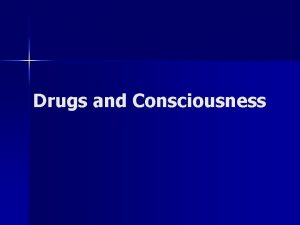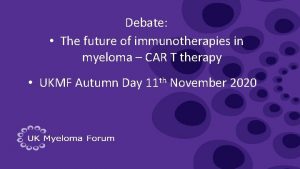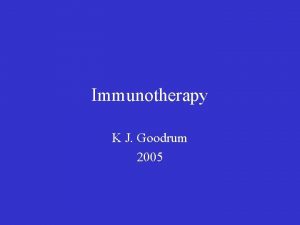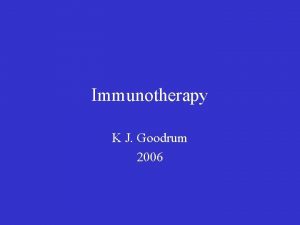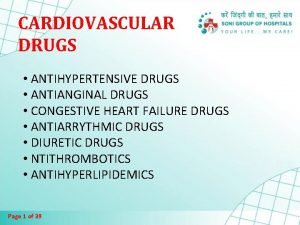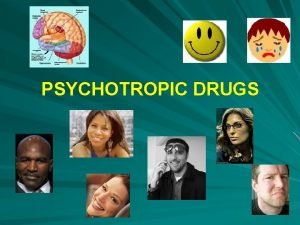Week 12 Immunomodulators immunostimulants and immunotherapies Immunomodulator drugs

























- Slides: 25

Week 12 Immunomodulators, immunostimulants, and immunotherapies

• Immunomodulator‐ drugs either suppress or stimulate the immune system (immunosppressants&immunostimulants) • Immunomodulating agents‐ downregulation of the harmful response‐ autoimmune disease &allergies • Meanwhile immunosuppresive agents‐lead opportunistic infections

Immunostimulants • I‐ Natural Endogenous Compounds • Thymic hormones • • • Thymosine fraction –V Thymosine α‐ 1 Thymopoietine Thymic hormonal factor Sera thymic factor • Cytokines • Interferons (IFN) • Interleukins (IL) • Opioid peptides (Endorphine, encephaline)

Immunostimulants • II. Synthetic compounds • • • Isoprinosine Levamisole Adenine arabinocide Filgrastime 8‐bromoguanosine Polynucleotide • III. Food Factors • Ascorbic acid • α‐tocopherol • Selenium

Immunostimulants • IV. Microbial derived substances • • • Lentinon Bacterial endotoxins Muramile dipeptide Propionibacterium acne Ubiquinone‐ 8 Loroyl tetrapeptide

Levamisole • Anthelmintic • Restoration of the depresssed immunofunction of B‐T lymphocyte, monocyte and macrophages Thalidomide • Increases TNFα • Teratogenic Isoprinosine • Production of cytokine IL‐ 1, IL‐ 2, IFN‐γ, increased proliferation of lymphocyte

immunomodulatory bacterins • Staphage lysate ‐ Staphylococcus aureus and polyvalent staphylococcus bacteriophage • S aureus bacterin‐toxoid‐prevention of staphylococcal mastitis‐ also in canine bacterial hypersensitivity. • Propionibacterium acnes bacterin is labeled for use in dogs‐proderma

Immunosuppresant Applications

Immunosuppresants • Selective inhibitors of cytokine production and function • Cyclosporine • Sirolimus • Tacrolimus (FK 506) • Immunosppresive antimetabolytes • Azathiopyrine • Microphenolate mofetile • Antibodies • • Antithymocite globulins Bacilicsimab Daclizumab Muromonab‐CD 3 • Adrenocorticoids • Methylprednizolone • Prednizone

Glucocorticoids Antimetabolytes Alkylating agents Azathioprine Methotraxate Mycophenolyte mofetil Leflunamide Cyclophosphamide Cyclosporine Tacrolymus, Sirolimus

Glucocorticoids • Downregulate the inflammatory mediators

Antimetabolites Azathioprine • Prodrug of 6 mercapto purine • Slow release of 6 mercaptopurine • pemphigus disorders, bullous pemphigoid and SLE in dogs, ocular inflammation in the uveodermatologic syndrome, and histiocytomas Methotraxate/MTX • Increase adenosine (endogenous antiinf. Mediator)‐ antiinflam. Effect • Cause apoptosis of activated CD 4 and CD 8

Antimetabolites Mycophenolic acid, Mycophenolate Mofetil • Inosine monophosphate dehydrogenase (rate limiting enzyme in the formation of guanosine) inhibition‐reduction of intracellular guanosine‐ elevation of intracellular adenosine • Act on lymphocytes Leflunomide • Inhibitor of pyrimidine synthesis

Alkylating agents form highly reactive intermediate compound‐ transfer alkyl groups to DNA. miscoding of DNA strands incomplete repair of alkylated segments (which leads to strand breakage or depurination) excessive cross‐linking of DNA inhibition of strand separation at mitosis. Cyclophosphamide • Attachment to the nucleophilic site on DNA‐Covalent attachment of alkyl group Alkylation of DNA • Guanosine imidazole irng cleavage‐abnormal base pairing‐depurin. • Cytotoxicity • Remember‐ lymphoma in dogs; also other types of cancers, rheumatoid arthritis, pemphigus complex, and vasculitis.

Crysotherapy • Gold salts • anti‐inflammatory, antirheumatic, immunomodulating, and antimicrobial (in vitro) effects • canine and feline pemphigus unresponsive to glucocorticoids and feline plasma cell pododermatitis.

Inhibition of lymphocyte signalling Cyclosporine, Tacrolimus • calcineurin inhibitor • inhibitory effects on T‐lymphocytes by decreasing production of cytokines, such as interleukin‐ 2 • Drugs inhibit CYP 450 3 A 4‐increased cyclosporine blood concentrations (vice versa) • contraindicated for use in dogs ‐malignant neoplasia • should not be given to breeding dogs • should not be given to pregnant or lactating bitches

Sirolimus • FKBP binding‐ blocking IL 2 receptor signaling (required for T cell proliferation)

Oclacitinib • Janus kinase (JAK) inhibitor • İnhibition‐ pruritogenic cytokines (eg, IL‐ 31) and pro‐inflammatory cytokines dependent on JAK 1 or JAK 3 enzyme activity • pruritus associated with allergic dermatitis in dogs

Cytokine Inhibition • TNFα Inhibitors • Etanercept • IL‐ 12/IL‐ 23 p 40 Inhibitors • Ustekinumab • IL 1 inhibitors • Anakinra • Cytokine receptor antagonists • Tocilizumab

Sulfones • Dapsone • anti‐inflammatory, antibacterial sulfone • İnhibition of neutrophil chemotaxis and adhesion to basement membrane zone antibodies, degranulation of mast cells, action of lysosomal enzymes, and activation of the alternative complement pathway. • İnhibition of synthesis of Ig. G, Ig. A, and prostaglandins, T‐cell responses. • Dermatosis in dogs

Tetracyclines • İnhibition of‐ lymphocyte blastogenic transformation and antibody production, activation of complement (component C 3), prostaglandin synthesis, lipases and collagenases, and suppress leukocyte chemotaxis • Niacinamide • blocks Ig. E‐induced histamine release • inhibits phosphodiesterases, and decreases protease release by leukocytes. • Tet+niacinamide‐ lupus erythematosus and pemphigus erythematosus.

Targeted antibody therapy • Polyclonal antibodies‐ antithymcyte globülin • Monoclonal‐ aganist CD 3, anti. CD 20 (rituximab), anti. CD 25 (daclizumab, basilizimab)

Blockade of cell adhesion • Alpha ‐ 4 integrins (α 4β 1 integrins, α 4β 7 integrins) • Natalizumab (monoclonal antibody against α 4 integrin)

Inhibition of complement activation • Eculizumab‐ humanized monoclonal antibody aganist complement protein 5

Immunisation • Vaccines and immunoglobulins • Recombinant Cytokines (interferon gamma‐ 1 b, interferon beta 1 a, interferon beta 1 b)
 Immunostimulants
Immunostimulants Week by week plans for documenting children's development
Week by week plans for documenting children's development Possibly armed probably not
Possibly armed probably not Intraperitoneal route advantages and disadvantages
Intraperitoneal route advantages and disadvantages Rate and rhythm control drugs
Rate and rhythm control drugs Neurotransmitters and drugs
Neurotransmitters and drugs Dried juice in pharmacognosy
Dried juice in pharmacognosy Section 35-1 human body systems answer key
Section 35-1 human body systems answer key Rate and rhythm control drugs
Rate and rhythm control drugs Chapter 19 lesson 2 using medicines safely
Chapter 19 lesson 2 using medicines safely Inhibitions drivers ed
Inhibitions drivers ed Clarke's analysis of drugs and poisons
Clarke's analysis of drugs and poisons Drugs and alcohol toolbox talk
Drugs and alcohol toolbox talk Blood shadow stays on the street
Blood shadow stays on the street Drugs that alter moods thoughts and sense perceptions
Drugs that alter moods thoughts and sense perceptions You must put all chemicals and drugs in locked cupboards
You must put all chemicals and drugs in locked cupboards Psychedelic drugs that distort perceptions and evoke
Psychedelic drugs that distort perceptions and evoke Drug that alters moods, thoughts, and sense perceptions
Drug that alters moods, thoughts, and sense perceptions First pass effect
First pass effect Chapter 15 alcohol other drugs and driving
Chapter 15 alcohol other drugs and driving Chemistry food and drugs
Chemistry food and drugs Namumetone
Namumetone Chapter 11 medications and drugs
Chapter 11 medications and drugs Storage and maintenance of drugs
Storage and maintenance of drugs Metabolic changes of drugs and related organic compounds
Metabolic changes of drugs and related organic compounds светр
светр
